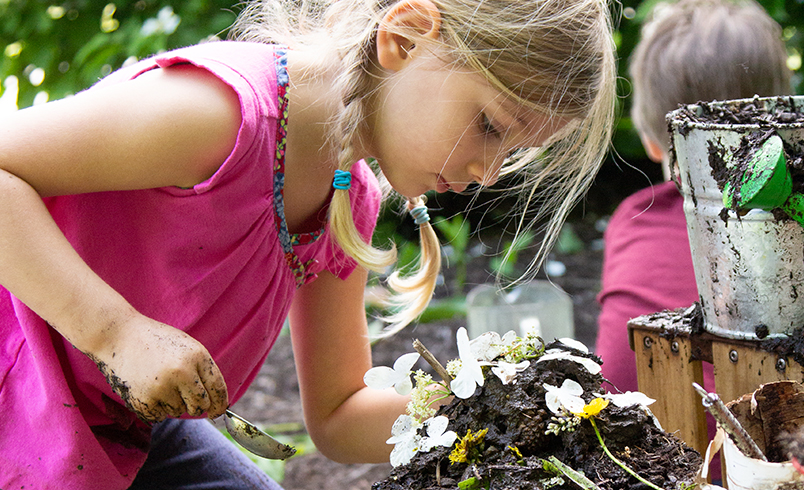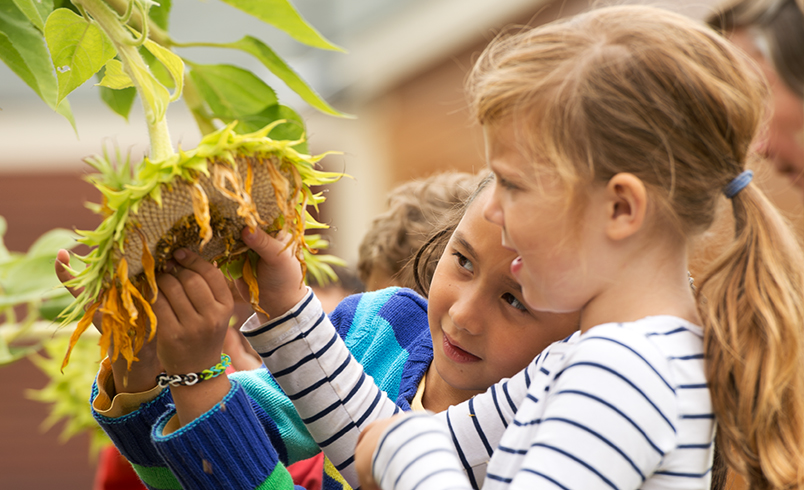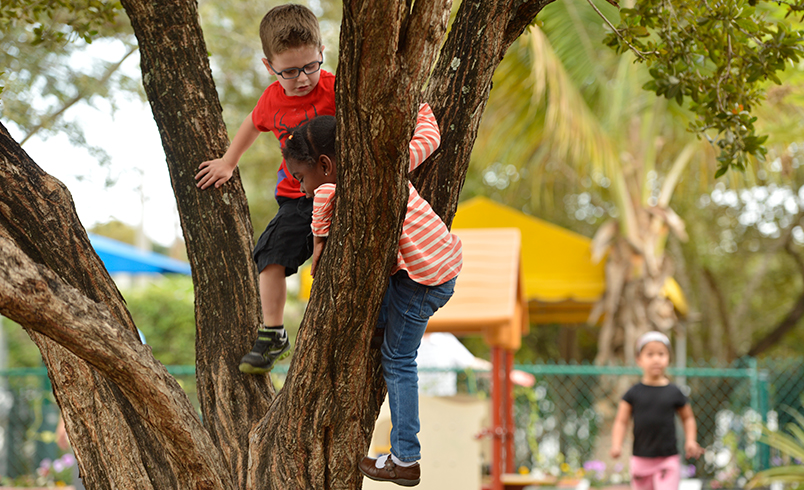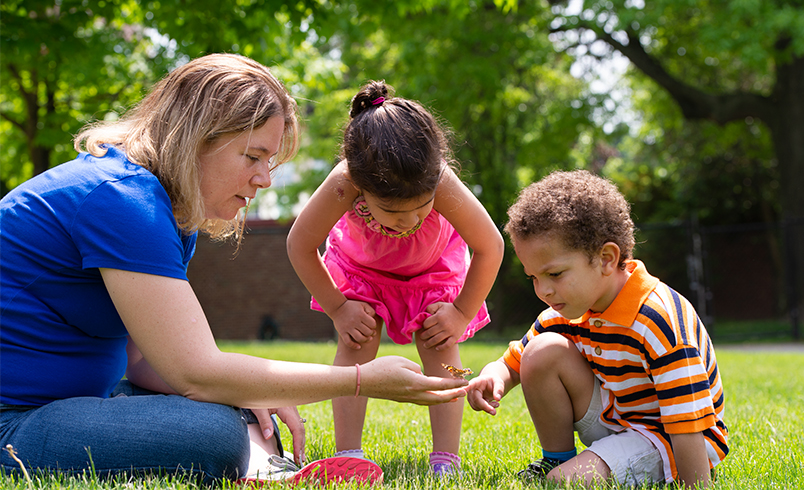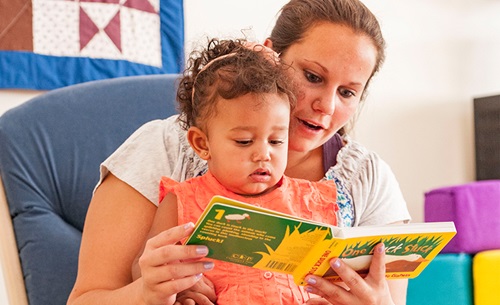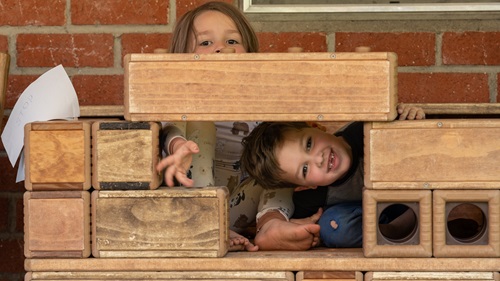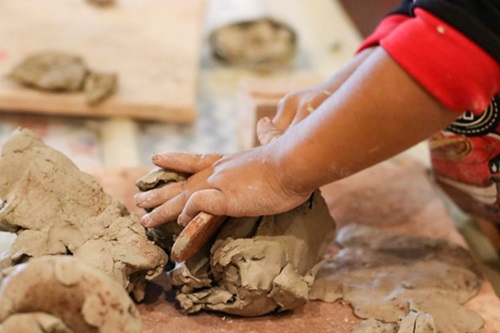Where the Magic Happens
Taking Your Play-Based Program Outdoors
| June 2023Children thrive outdoors. Children thrive with play. Very few of us will contradict these two points. Early childhood researchers, authors, and organizations such as NAEYC, point to the need for play-based, outdoor learning approaches for young children. But even so, there remains very little guidance in implementing these approaches.
At Woodland Playhouse, our preschool in rural New York, we were already moving toward outdoor programming back in fall of 2019. The pandemic pushed us to make these changes quicker than we originally planned. Despite the pressure to reopen we wanted to do this with intention and consideration. When we reopened our doors during the summer of 2020, we were operating nine separate camps with exclusively outdoor programming. While this does not make us experts, it certainly gives us an abundance of experience to share.
As we continued moving our programming outdoors, some of the questions we asked ourselves were: “What defines play-based learning?” “Why should we go outside?” and “How long should we stay outside?” As we examined these questions, we began to realize the importance of outdoor play more deeply. And then the magic started.
What defines play-based learning?
Playful learning, or play-based learning, has been defined and redefined throughout the years, but is consistently considered to be child-directed, voluntary, and enjoyable (Daniels, 2018 and Rieber, 1996). When setting up your program (both indoors and outdoors), it is important to consider your play goals for the group:
- Are you setting up your space for free play or guided play?
- Are you considering play for academic learning, developmental learning, or both?
Consider how you operate for these goals and intentions indoors when making your plans for the outdoors. Adequate preparations and clearly defined expectations will support quality outdoor experiences.
Why are we going outside?
There are many positive reasons for outdoor play.
Time outside:
- is regulating.
- offers opportunities for built in differentiation (playgrounds, sandboxes, tabletop activities, gross motor movements).
- offers mental health benefits (fresh air, free movement, opportunities for social interactions).
- offers physical health benefits (big movements, motor activities, heavy work, fresh air).
- encourages risky play.
- provides abundant opportunities for child-led play and learning.
Scheduling regular outdoor time on your daily calendar is a powerful visual reminder of its importance. Children see what’s on our daily schedules, the image of outdoor time shows that it is a priority.
Recently, on a chilly, rainy, muddy day I was not feeling motivated to go outdoors. The children and my co-workers, however, held me accountable to our daily plan and out we went to explore the thawing wilderness. Taking time outdoors completely changed the mood of the staff and children. Despite the weather the immediate effects on self-regulation and physical and mental health were apparent. It was magical. Nature’s gifts are free!
How can we take learning outdoors?
Learning can happen anywhere! That's part of the magic of taking play-based learning outdoors. Rooftop playgrounds, neighborhood parks, or small urban spaces may look different but can contain similar learning opportunities. Just as we find the teachable moments inside our classroom, we can find them outside our classroom walls as well.
Spending time outside is more than just a chance to “get out the big energy”. It is possible to provide meaningful play and learning opportunities as well as intentional invitations for play for children across all ages outdoors.
Educators and providers sometimes hold back from moving traditional indoor activities to the outdoors. But these can be some of the best outdoor activities. Bring a story book outside and read in the grass! Try attaching some paper to the fence and let children paint and create. Table-top and fine motor activities also work very successfully outdoors.
What do we need to be successful outdoors?
Here are the most important considerations for outdoor success. You will need:
- A plan: Create a plan and set expectations for the day, deciding what items to bring outdoors and which part of the outdoor space to visit or utilize.
- The right space: Think about your goals for the day and select your space accordingly. Do what you can to improve each space to meet your goals and needs.
- Proper gear (clothes especially): This is essential to the success of your outdoor time. No one—adults or children—likes to feel uncomfortable.
- Real materials: Sometimes these materials may be found items in the world around you, and other times they may be things you bring with you such as magnifying glasses, books, or other manipulatives.
- Support: Communicate your intentions and share research to back up those intentions with all staff in your program as well as the parents and children.
- Confidence: While communicating with your team, parents, and students, be sure to show your excitement and confidence in steering your program to more outdoor learning time. It’s reassuring for everyone.
- Positivity: If you’re making a shift to spend more time outdoors, you’re doing it in the best interest of all members of your program. You should feel good about that decision!
How long should we be outside?
Answers to this question will vary according to a program’s staff, students, environments, and unpredictable daily considerations. In my program, we’re fortunate to have several outdoor spaces. Some days we hike for up to one and a half hours in the forest, exploring rocks, trees, and plants.
Other days, when the weather is good, we bring materials out to our “little yard” which includes a covered deck, a sandbox, and a play structure. The yard offers easy access to books, tabletop activities, and gross motor play. Such days are spent almost entirely outdoors.
Of course, there are other days when it is cold, wet, or generally uncomfortable outside so we gear up to spend just twenty minutes outdoors. The ability to adjust schedules and remain flexible is crucial to the success of an outdoor program.
What is the role of the teacher?
It’s important to consider the educators’ role during outdoor play. In a study conducted by Nicole Leggett & Linda Newman of the University of Newcastle in Australia (2017) an interesting shift was observed in teachers’ perceived roles during outdoor play. Instead of “educators”, the adults viewed themselves as "supervisors”. Reflect, for a moment, how you might shift your thinking from “supervisor” back to “educator” when you’re outdoors. Soon you will feel free and comfortable experimenting with other things (like changing your location). Your outdoor experiences should feel like indoor ones—empowering, engaging, and authentic.
Confidence and excitement are contagious. Hopefully your co-workers will see the positive outcomes of outdoor play and support you.
How can I bring the magic to my program?
- Start one day at a time—by prioritizing time outdoors each day you are setting the expectations for not only your students, but for your staff and yourself as well.
- Practice! Take the activities you’re most confident with outdoors first, then stretch yourself to places you are less comfortable.
- Set goals—long term goals, short term goals, and intermediate goals.
- Keep track of what’s working in your outdoor space. What materials or strategies might you need to implement or include to maximize your success?
- Think BIG. Get out of your own way and imagine endless possibilities without any financial tie backs. What would your most ideal outdoor space look like? How can you get there?
- Excitement is infectious. Get excited about the changes you’re making; tell your team and your students and get everyone as excited as you are.
- Be confident. You’re working to improve the quality of your programming and the experiences of your students.
Play-based outdoor experiences are deeply valuable for young children’s growth and development. Using the above guidelines hopefully you can offer as many of these experiences as possible. With the right tools, approaches, and support systems, children at your program will come to love being outside. That is where the magic happens.
References
Rieber, L. P. “Seriously considering play: Designing interactive learning environments based on the blending of microworlds, simulations, and games.” Educational Technology Research & Development, 44 (2016): 43-58.
Danniels, Erica, and Angela Pyle. "Defining play-based learning." Encyclopedia on early childhood development (2018): 1-5.
Leggett, Nicole, and Linda Newman. "Play: Challenging educators' beliefs about play in the indoor and outdoor environment." Australasian Journal of Early Childhood 42.1 (2017): 24-32.
Check out Christina's Learning Lab: Where the Magic Happens: Bringing Play-based Learning Outdoors.
It's a one-hour certified training session available until August 31, 2023.

